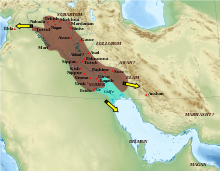Our website is made possible by displaying online advertisements to our visitors.
Please consider supporting us by disabling your ad blocker.
Subartu

The land of Subartu (Akkadian: Šubartum/Subartum/ina Šú-ba-ri, Assyrian:[clarification needed] mât Šubarri) or Subar (Sumerian: Su-bir4/Subar/Šubur, Ugaritic: 𐎘𐎁𐎗 ṯbr) is mentioned in Bronze Age literature. The name also appears as Subari in the Amarna letters, and, in the form Šbr, in Ugarit.
Subartu was apparently a kingdom in Upper Mesopotamia, at the upper Tigris and later it referred to a region of Mesopotamia. Most scholars suggest that Subartu is an early name for people of upper Mesopotamia proper on the Tigris and westward, although there are various other theories placing it sometimes a little farther to the east and/or north. Its precise location has not been identified. From the point of view of the Akkadian Empire, Subartu marked the northern geographical horizon, just as Amurru, Elam and Sumer marked "west", "east" and "south", respectively, functioning as a term to mean 'north'.[1]
- ^ McMahon, Augusta (2013), "North Mesopotamia in the third millennium BC", The Sumerian World, pp. 486–501, doi:10.4324/9780203096604-37, ISBN 9780203096604, retrieved 1 March 2023
Previous Page Next Page


